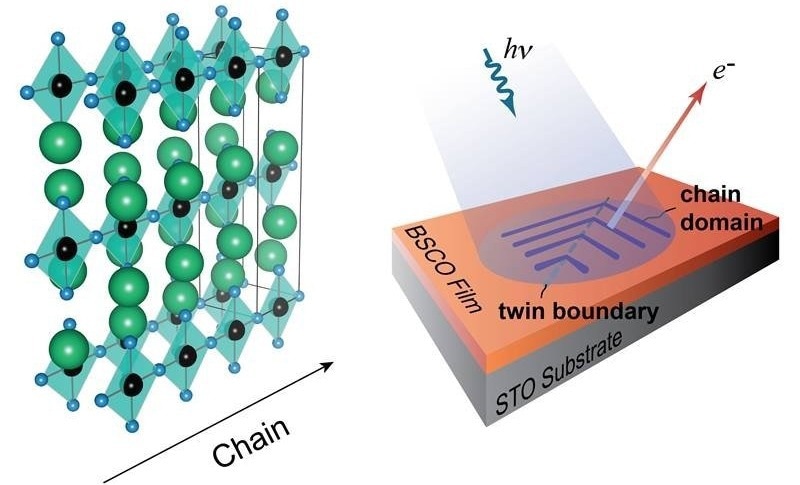There are materials that consist of unique properties, like superconductivity, that can only be understood utilizing the rules of quantum mechanics.

The crystal structure of a thin film of cuprate material. One-dimensional copper-oxygen chains run parallel to the film surface in a staggered stacking pattern. X-rays are used to eject electrons and measure the electronic states in the film. Image Credit: SLAC National Accelerator Laboratory
One method that researchers use to make a comparison of experiments and computations is to utilize sample materials that separate and stress an atomic line with one-dimensional (1D) properties. In this study, researchers grew thin films of layered copper-oxygen (cuprate) materials to separate 1D copper chains.
In quantum materials, this enabled them to test theories of how electrons communicate. They grew the films under conditions that enabled them to cautiously alter the chemistry and electronic structure of the films.
Further, they quantified the electronic structure. The study was made feasible in part because of a specialized synchrotron X-ray beam line developed and constructed for this purpose.
The Impact
Explaining how the properties of quantum materials interact and testing concerning theories are mathematically highly complicated and labor-intensive. This study allowed a direct comparison of computational outcomes against experimental measurements.
The study shows that standard theory is not adequate and needs a new term to suit the experimental data. The work will help researchers improve theories that are necessary for explaining and engineering new quantum materials and effects. Ultimately, this could result in new quantum electronic devices.
Summary
At present, it is impossible to computationally resolve the electronic structure of multi-dimensional quantum materials. The 1D theory has been computationally feasible but hard to test because the majority of the materials consist of 3D structures.
The inherently layered 2D cuprate materials’ structure could be rearranged when synthesized in the ultra-thin limit, leading to 1D copper-oxygen chains that run parallel to the material surface. But to completely test theories of electron interactions and transport, scientists also require well-specified “doping” defects in the cuprate oxygen stoichiometry.
In this study, researchers worked out a synthesis method, utilizing ozone at the time of molecular beam epitaxial growth to add additional oxygen atoms that grab electrons from the copper atoms and make holes in the electronic structure.
This was performed at a thin film deposition station linked to a synchrotron X-ray beamline that was developed with a sensitive X-ray photoemission spectroscopy ability that could map out the consequent electronic structure.
By making a comparison of the experimental outcomes with theory, the scientists showed that the standard theory of electron interactions and transport could not forecast the 1D doping effects without a modification that has been utilized to display a remarkably powerful attraction between some electrons at longer separations.
This attraction is intervened by atomic vibrations. Comprehending the coupling between defects, chemistry, vibrations, and the spin direction of electrons is an essential part of engineering quantum materials for future devices.
This study offers a required direct connection between theory and experiment at the level of correlated electron theory.
This study was financially supported by the Department of Energy (DOE) Office of Science, Office of Basic Energy Sciences, Materials Sciences and Engineering Division.
Film growth and X-ray ARPES experiments were executed at Beamline 5-2 of the Stanford Synchrotron Radiation Light Source, a DOE Office of Science user facility at SLAC National Accelerator Laboratory.
Computational resources were offered by the National Energy Research Scientific Computing Center, a DOE Office of Science user facility.
Journal Reference
Zhuoyu, C., et al. (2023) Anomalously strong near-neighbor attraction in doped 1D cuprate chains. Science. doi.org/10.1126/science.abf5174.